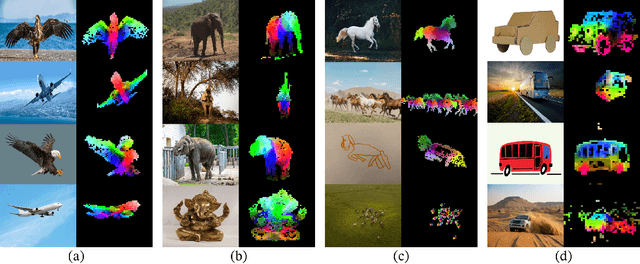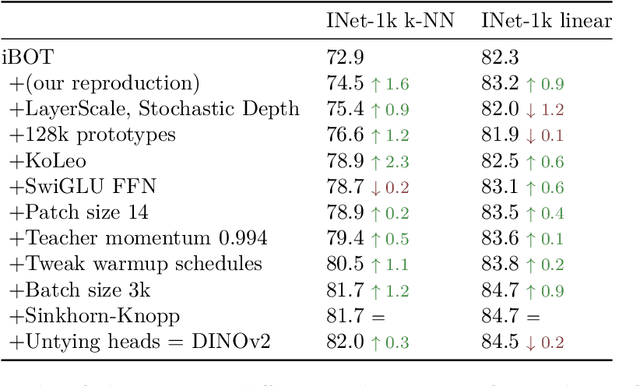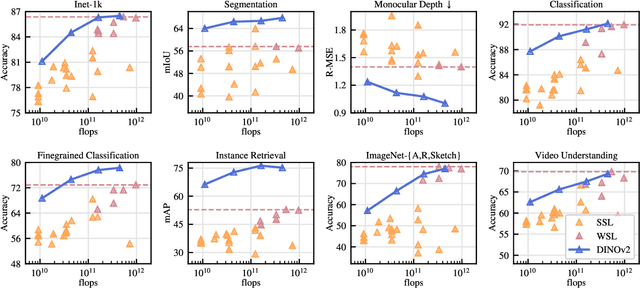Michael Rabbat
McGill University, Montreal, Canada
Scaling Language-Free Visual Representation Learning
Apr 01, 2025Abstract:Visual Self-Supervised Learning (SSL) currently underperforms Contrastive Language-Image Pretraining (CLIP) in multimodal settings such as Visual Question Answering (VQA). This multimodal gap is often attributed to the semantics introduced by language supervision, even though visual SSL and CLIP models are often trained on different data. In this work, we ask the question: "Do visual self-supervised approaches lag behind CLIP due to the lack of language supervision, or differences in the training data?" We study this question by training both visual SSL and CLIP models on the same MetaCLIP data, and leveraging VQA as a diverse testbed for vision encoders. In this controlled setup, visual SSL models scale better than CLIP models in terms of data and model capacity, and visual SSL performance does not saturate even after scaling up to 7B parameters. Consequently, we observe visual SSL methods achieve CLIP-level performance on a wide range of VQA and classic vision benchmarks. These findings demonstrate that pure visual SSL can match language-supervised visual pretraining at scale, opening new opportunities for vision-centric representation learning.
Accelerating Neural Network Training: An Analysis of the AlgoPerf Competition
Feb 20, 2025Abstract:The goal of the AlgoPerf: Training Algorithms competition is to evaluate practical speed-ups in neural network training achieved solely by improving the underlying training algorithms. In the external tuning ruleset, submissions must provide workload-agnostic hyperparameter search spaces, while in the self-tuning ruleset they must be completely hyperparameter-free. In both rulesets, submissions are compared on time-to-result across multiple deep learning workloads, training on fixed hardware. This paper presents the inaugural AlgoPerf competition's results, which drew 18 diverse submissions from 10 teams. Our investigation reveals several key findings: (1) The winning submission in the external tuning ruleset, using Distributed Shampoo, demonstrates the effectiveness of non-diagonal preconditioning over popular methods like Adam, even when compared on wall-clock runtime. (2) The winning submission in the self-tuning ruleset, based on the Schedule Free AdamW algorithm, demonstrates a new level of effectiveness for completely hyperparameter-free training algorithms. (3) The top-scoring submissions were surprisingly robust to workload changes. We also discuss the engineering challenges encountered in ensuring a fair comparison between different training algorithms. These results highlight both the significant progress so far, and the considerable room for further improvements.
Intuitive physics understanding emerges from self-supervised pretraining on natural videos
Feb 17, 2025Abstract:We investigate the emergence of intuitive physics understanding in general-purpose deep neural network models trained to predict masked regions in natural videos. Leveraging the violation-of-expectation framework, we find that video prediction models trained to predict outcomes in a learned representation space demonstrate an understanding of various intuitive physics properties, such as object permanence and shape consistency. In contrast, video prediction in pixel space and multimodal large language models, which reason through text, achieve performance closer to chance. Our comparisons of these architectures reveal that jointly learning an abstract representation space while predicting missing parts of sensory input, akin to predictive coding, is sufficient to acquire an understanding of intuitive physics, and that even models trained on one week of unique video achieve above chance performance. This challenges the idea that core knowledge -- a set of innate systems to help understand the world -- needs to be hardwired to develop an understanding of intuitive physics.
Towards General-Purpose Model-Free Reinforcement Learning
Jan 27, 2025



Abstract:Reinforcement learning (RL) promises a framework for near-universal problem-solving. In practice however, RL algorithms are often tailored to specific benchmarks, relying on carefully tuned hyperparameters and algorithmic choices. Recently, powerful model-based RL methods have shown impressive general results across benchmarks but come at the cost of increased complexity and slow run times, limiting their broader applicability. In this paper, we attempt to find a unifying model-free deep RL algorithm that can address a diverse class of domains and problem settings. To achieve this, we leverage model-based representations that approximately linearize the value function, taking advantage of the denser task objectives used by model-based RL while avoiding the costs associated with planning or simulated trajectories. We evaluate our algorithm, MR.Q, on a variety of common RL benchmarks with a single set of hyperparameters and show a competitive performance against domain-specific and general baselines, providing a concrete step towards building general-purpose model-free deep RL algorithms.
MetaMorph: Multimodal Understanding and Generation via Instruction Tuning
Dec 18, 2024Abstract:In this work, we propose Visual-Predictive Instruction Tuning (VPiT) - a simple and effective extension to visual instruction tuning that enables a pretrained LLM to quickly morph into an unified autoregressive model capable of generating both text and visual tokens. VPiT teaches an LLM to predict discrete text tokens and continuous visual tokens from any input sequence of image and text data curated in an instruction-following format. Our empirical investigation reveals several intriguing properties of VPiT: (1) visual generation ability emerges as a natural byproduct of improved visual understanding, and can be unlocked efficiently with a small amount of generation data; (2) while we find understanding and generation to be mutually beneficial, understanding data contributes to both capabilities more effectively than generation data. Building upon these findings, we train our MetaMorph model and achieve competitive performance on both visual understanding and generation. In visual generation, MetaMorph can leverage the world knowledge and reasoning abilities gained from LLM pretraining, and overcome common failure modes exhibited by other generation models. Our results suggest that LLMs may have strong "prior" vision capabilities that can be efficiently adapted to both visual understanding and generation with a relatively simple instruction tuning process.
Dualformer: Controllable Fast and Slow Thinking by Learning with Randomized Reasoning Traces
Oct 13, 2024Abstract:In human cognition theory, human thinking is governed by two systems: the fast and intuitive System 1 and the slower but more deliberative System 2. Recent studies have shown that incorporating System 2 process into Transformers including large language models (LLMs), significantly enhances their reasoning capabilities. Nevertheless, models that purely resemble System 2 thinking require substantially higher computational costs and are much slower to respond. To address this challenge, we present Dualformer, a single Transformer model that seamlessly integrates both the fast and slow reasoning modes. Dualformer is obtained by training on data with randomized reasoning traces, where different parts of the traces are dropped during training. The dropping strategies are specifically tailored according to the trace structure, analogous to analyzing our thinking process and creating shortcuts with patterns. At inference time, our model can be configured to output only the solutions (fast mode) or both the reasoning chain and the final solution (slow mode), or automatically decide which mode to engage (auto mode). In all cases, Dualformer outperforms the corresponding baseline models in both performance and computational efficiency: (1) in slow mode, Dualformer optimally solves unseen 30 x 30 maze navigation tasks 97.6% of the time, surpassing the Searchformer (trained on data with complete reasoning traces) baseline performance of 93.3%, while only using 45.5% fewer reasoning steps; (2) in fast mode, Dualformer completes those tasks with an 80% optimal rate, significantly outperforming the Solution-Only model (trained on solution-only data), which has an optimal rate of only 30%. For math problems, our techniques have also achieved improved performance with LLM fine-tuning, showing its generalization beyond task-specific models.
Embracing Diversity: Interpretable Zero-shot classification beyond one vector per class
Apr 25, 2024Abstract:Vision-language models enable open-world classification of objects without the need for any retraining. While this zero-shot paradigm marks a significant advance, even today's best models exhibit skewed performance when objects are dissimilar from their typical depiction. Real world objects such as pears appear in a variety of forms -- from diced to whole, on a table or in a bowl -- yet standard VLM classifiers map all instances of a class to a \it{single vector based on the class label}. We argue that to represent this rich diversity within a class, zero-shot classification should move beyond a single vector. We propose a method to encode and account for diversity within a class using inferred attributes, still in the zero-shot setting without retraining. We find our method consistently outperforms standard zero-shot classification over a large suite of datasets encompassing hierarchies, diverse object states, and real-world geographic diversity, as well finer-grained datasets where intra-class diversity may be less prevalent. Importantly, our method is inherently interpretable, offering faithful explanations for each inference to facilitate model debugging and enhance transparency. We also find our method scales efficiently to a large number of attributes to account for diversity -- leading to more accurate predictions for atypical instances. Finally, we characterize a principled trade-off between overall and worst class accuracy, which can be tuned via a hyperparameter of our method. We hope this work spurs further research into the promise of zero-shot classification beyond a single class vector for capturing diversity in the world, and building transparent AI systems without compromising performance.
Beyond A*: Better Planning with Transformers via Search Dynamics Bootstrapping
Feb 21, 2024Abstract:While Transformers have enabled tremendous progress in various application settings, such architectures still lag behind traditional symbolic planners for solving complex decision making tasks. In this work, we demonstrate how to train Transformers to solve complex planning tasks and present Searchformer, a Transformer model that optimally solves previously unseen Sokoban puzzles 93.7% of the time, while using up to 26.8% fewer search steps than standard $A^*$ search. Searchformer is an encoder-decoder Transformer model trained to predict the search dynamics of $A^*$. This model is then fine-tuned via expert iterations to perform fewer search steps than $A^*$ search while still generating an optimal plan. In our training method, $A^*$'s search dynamics are expressed as a token sequence outlining when task states are added and removed into the search tree during symbolic planning. In our ablation studies on maze navigation, we find that Searchformer significantly outperforms baselines that predict the optimal plan directly with a 5-10$\times$ smaller model size and a 10$\times$ smaller training dataset. We also demonstrate how Searchformer scales to larger and more complex decision making tasks like Sokoban with improved percentage of solved tasks and shortened search dynamics.
A Distributed Data-Parallel PyTorch Implementation of the Distributed Shampoo Optimizer for Training Neural Networks At-Scale
Sep 12, 2023



Abstract:Shampoo is an online and stochastic optimization algorithm belonging to the AdaGrad family of methods for training neural networks. It constructs a block-diagonal preconditioner where each block consists of a coarse Kronecker product approximation to full-matrix AdaGrad for each parameter of the neural network. In this work, we provide a complete description of the algorithm as well as the performance optimizations that our implementation leverages to train deep networks at-scale in PyTorch. Our implementation enables fast multi-GPU distributed data-parallel training by distributing the memory and computation associated with blocks of each parameter via PyTorch's DTensor data structure and performing an AllGather primitive on the computed search directions at each iteration. This major performance enhancement enables us to achieve at most a 10% performance reduction in per-step wall-clock time compared against standard diagonal-scaling-based adaptive gradient methods. We validate our implementation by performing an ablation study on training ImageNet ResNet50, demonstrating Shampoo's superiority over standard training recipes with minimal hyperparameter tuning.
DINOv2: Learning Robust Visual Features without Supervision
Apr 14, 2023



Abstract:The recent breakthroughs in natural language processing for model pretraining on large quantities of data have opened the way for similar foundation models in computer vision. These models could greatly simplify the use of images in any system by producing all-purpose visual features, i.e., features that work across image distributions and tasks without finetuning. This work shows that existing pretraining methods, especially self-supervised methods, can produce such features if trained on enough curated data from diverse sources. We revisit existing approaches and combine different techniques to scale our pretraining in terms of data and model size. Most of the technical contributions aim at accelerating and stabilizing the training at scale. In terms of data, we propose an automatic pipeline to build a dedicated, diverse, and curated image dataset instead of uncurated data, as typically done in the self-supervised literature. In terms of models, we train a ViT model (Dosovitskiy et al., 2020) with 1B parameters and distill it into a series of smaller models that surpass the best available all-purpose features, OpenCLIP (Ilharco et al., 2021) on most of the benchmarks at image and pixel levels.
 Add to Chrome
Add to Chrome Add to Firefox
Add to Firefox Add to Edge
Add to Edge